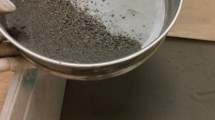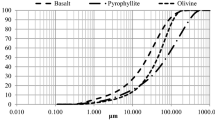Abstract
The goal of this research is to evaluate the influence of steel fibres and expanded vermiculite on some physical and mechanical properties of lightweight mortar at elevated temperatures. An experimental program has been carried out on lightweight mortar specimens exposed to high temperatures up to 1100 °C, combining different concentrations of both, steel fibres as a reinforcement of the mortar and expanded vermiculite. The target properties of the mortar to be determined were the flexural strength, the compressive strength and the ultrasonic pulse velocity of hardened mortar after air cooling. Non-linear models derived from a regression analysis and 3D graphics for the measured properties with good agreement to the test results are also presented. Lightweight mortar with expanded vermiculite shows a good performance at elevated temperatures that improves as the percentage of added fibre increases.












Similar content being viewed by others
References
Husem M (2006) The effects of high temperature on compressive and flexural strengths of ordinary and high-performance concrete. Fire Saf J 41:155–163
Arioz O (2007) Effects of elevated temperatures on properties of concrete. Fire Saf J 42:516–522
Bastami M, Chaboki-Khiabani A, Baghbadrani M, Kordi M (2011) Performance of high strength concretes at elevated temperatures. Sci Iran 18:1028–1036
Koksal F, Gencel O, Brostow W, Hagg Lobland HE (2012) Effect of high temperature on mechanical and physical properties of lightweight cement based refractory including expanded vermiculite. Mater Res Innov 16:7–13
Gai-Fei P, Zhi-Shan H (2008) Change in microstructure of hardened cement paste subjected to elevated temperatures. Constr Build Mater 22:593–599
Bingol AF, Gul R (2004) Compressive strength of lightweight aggregate concrete exposed to high temperatures. Indian J Eng Mater 11:68–72
Poon CS, Shui ZH, Lam L (2004) Compressive behavior of fiber reinforced high-performance concrete subjected to elevated temperatures. Cem Concr Res 34:2215–2222
Khaliq W, Kodur V (2011) Thermal and mechanical properties of fiber reinforced high performance self-consolidating concrete at elevated temperatures. Cem Concr Res 41:1112–1122
Wenzhong Z, Haiyan L, Ying W (2012) Compressive behaviour of hybrid fiber-reinforced reactive powder concrete after high temperature. Mater Des 41:403–409
Gencel O (2011) Effect of elevated temperatures on mechanical properties of high strength concrete containing varying proportions of hematite. Fire Mater 36(3):217–230
Brandt AM (2008) Fibre reinforced cement-based (FRC) composites after over 40 years of development in building and civil engineering. Compos Struct 86:3–9
Zollo RF (1997) Fiber-reinforced concrete: an overview after 30 years of development. Cem Concr Compos 19:107–122
Romualdi JP, Batson GB (1963) Mechanics of crack arrest in concrete. J Eng Mech Div ASCE Proc 89(EM3):147–168
Romualdi JP, Mandel JA (1964) Tensile strength of concrete affected by uniformly distributed and closely spaced short lengths of wire reinforcement. J ACI 61:657–670
Grimaldi A, Luciano R (2000) Tensile stiffness and strength of fiber-reinforced concrete. J Mech Phys Solids 48:1987–2008
Olivito RS, Zuccarello FA (2010) An experimental study on the tensile strength of steel fiber reinforced concrete. Compos B 41:246–255
Johnston CD (1982) Steelfibre-reinforced concrete: present and future in engineering construction. Composites 13(2):113–121
Sevil T, Baran M, Bilir T, Canbay E (2011) Use of steel fiber reinforced mortar for seismic strengthening. Constr Build Mater 25:892–899
Gencel O, Brostow W, Tea D, Thedford M (2011) Workability and mechanical performance of steel-fiber-reinforced self-compacting concrete with fly ash. Compos Interfaces 18(2):169–184
Koksal F, Gencel O, Unal B, Durgun MY (2012) Durability properties of concrete reinforced with steel-polypropylene hybrid fibers. Sci Eng Compos Mater 19(1):19–27
ASTM 1018 (1997) Standard test method for flexural toughness and first-crack strength of fiber reinforced concrete. ASTM International, Conshohocken
Standards for Test Methods of Fiber Reinforced Concrete (1984) SF-4: method of test for flexural strength and flexural toughness of fiber reinforced concrete. Japan Society of Civil Engineers, Tokyo
Vandewalle L (2003) RILEM TC 162-TDF, test and design methods for steel fibre reinforced concrete: σ–ε design method. Final recommendation. Mater Struct 36:560–567
European Committee for Standardization (CEN) (2003) Steel fibre reinforced concrete: definitions, classification and designation. UNI 11039-1
European Committee for Standardization (CEN) (2003) Steel fibre reinforced concrete: test method for determination of first crack strength and ductility indexes. UNI 11039-2
Naam AE (2003) Strain hardening and deflection hardening fiber reinforced cement composites. In: Reinhardt HW, Naaman AE (ed) Proceedings of the international RILEM workshop ‘High performance fiber reinforced cement composites’ HPFRCC4, Ann Arbor, pp 95–113
Purkiss JA (1984) Steel fibre reinforced concrete at elevated temperatures. Int J Cem Compos Lightweight Concr 6:179–184
Gai-Fei P, Wen-Wu Y, Jie Z, Ye-Feng L, Song-Hua B, Li-Hong Z (2006) Explosive spalling and residual mechanical properties of fiber-toughened high-performance concrete subjected to high temperatures. Cem Concr Res 36:723–727
Ding Y, Azevedo C, Aguiar JB, Jalali S (2012) Study on residual behaviour and flexural toughness of fibre cocktail reinforced self compacting high performance concrete after exposure to high temperature. Constr Build Mater 26:21–31
Çavdar A (2012) A study on the effects of high temperature on mechanical properties of fiber reinforced cementitious composites. Compos B 43:2452–2463
The Vermiculite Association. The world of vermiculite. http://www.vermiculite.org/index.php. Accessed 30 Aug 2012
Gerard VM (2003) Encyclopedia of sediments and sedimentary rocks. Kluwer Academic Publishers, Cornwall
The European Standard (1999) Methods of test for mortar for masonry. Part 11: determination of flexural and compressive strength of hardened mortar. BS EN 1015-11
ASTM C597 Standard test method for pulse velocity through concrete, Annual Book of ASTM Standards, vol 04.02, Philadelphia
Author information
Authors and Affiliations
Corresponding author
Rights and permissions
About this article
Cite this article
Köksal, F., Serrano-López, M.A., Şahin, M. et al. Combined effect of steel fibre and expanded vermiculite on properties of lightweight mortar at elevated temperatures. Mater Struct 48, 2083–2092 (2015). https://doi.org/10.1617/s11527-014-0294-7
Received:
Accepted:
Published:
Issue Date:
DOI: https://doi.org/10.1617/s11527-014-0294-7




